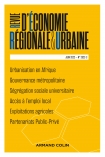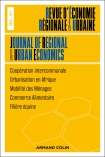
Revue d'économie régionale et urbaine (5/2020)
Pour acheter ce numéro, contactez-nous
Recevez les numéros de l'année en cours et accédez à l'intégralité des articles en ligne.
La conversion urbaine de terres non bâties fait l’objet d’un débat social où la préservation des ressources agricoles et de l’environnement s’opposent aux besoins de logements et de locaux d’entreprises. Notre contribution concerne les déterminants spatiaux de cette question. Nous utilisons une nouvelle base de données issue des fichiers fiscaux (2009-2017), exploitée par CEREMA, qui fournit des données au niveau communal. La conversion urbaine de terres non bâties est très inégalement répartie dans l’espace. Pour analyser ses déterminants, un modèle économétrique est estimé par la méthode des variables instrumentales. Les résultats montrent que l’urbanisation est d’autant plus forte que les unités urbaines sont grandes. Elle opère surtout par construction sur des parcelles agro-forestières dans les métropoles, où les ressources foncières sont rares et chères. D’autres variables géographiques, parmi lesquelles le littoral, ou d’autres aménités, comme le climat, contribuent à accroître les conversions urbaines de terres.
Land development triggers a social debate in France, as in Europe, opposing, on the one hand, the preservation of agriculture and of the environment and, on the other hand, the needs for dwellings and offices, shops, and factories. Our contribution relates to spatial determinants of this question. We use a new database gathering tax files data (2009-2017), operated by CEREMA, the French Administration in charge of the management of this database. It provides data at the geographic level of the 33,872 French municipalities included in the study. We observe that urban land conversion is very unevenly distributed in space. To analyze the determinants of this distribution, an econometric model is estimated by the method of instrumental variables that takes into account the endogeneity of some variables. As predicted by geographical economics theory, the results show the key role of agglomeration forces in the urban conversion of undeveloped land: the more population and the higher the productivity, the more conversions. Urbanization consumes land especially in the largest urban areas of the country, especially since they are large, and the location is close to the urban center. Urbanization operates more by development on new plots in metropolitan areas, where land resources are scarce and expensive. These results show that the urban conversion of land have to be managed at a local level: on the one hand, the metropolization mechanisms create jobs and lead to increases in income; on the other hand, non-metropolitan areas have low needs for urbanization. Other geographic variables, related to the « first Nature » of Krugman analysis, such as the shoreline, or other amenities, such as climate, contribute to increased urban land conversions.

